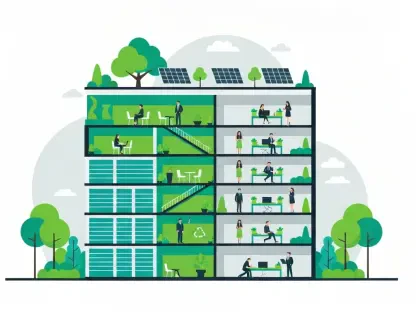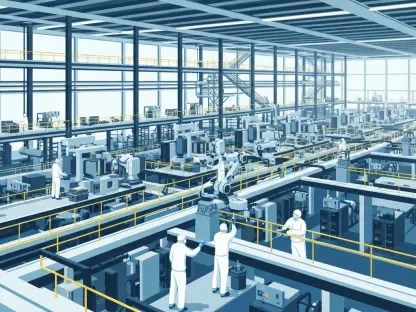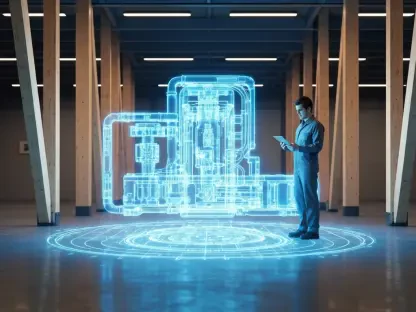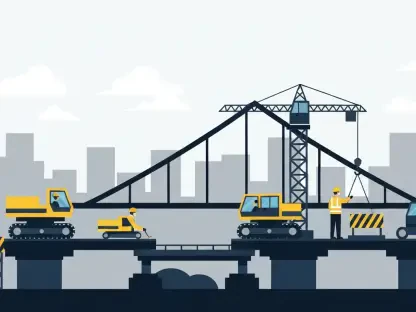The global nuclear reactor construction market is poised for substantial growth from 2024 to 2032. This market is set to expand from $7 billion in 2023 to $9.3 billion by 2032, driven by rising energy demands, climate change concerns, and advancements in nuclear technology. Governments and private industries alike are investing heavily to meet the expected surge in demand, which may lead to noticeable advancements and innovations in this sector.
Global Market Overview
Current Market Size and Projections
The nuclear reactor construction market reached a significant size of $7 billion in 2023, and it shows no signs of slowing down. Projected to grow at a compound annual growth rate (CAGR) of 3.2% from 2023 to 2032, the market is expected to achieve a valuation of $9.3 billion by the end of this period. This growth highlights the increasing dependence on nuclear energy as a reliable and efficient power source worldwide. The focus on sustainable energy solutions has made nuclear power a crucial part of global energy strategies, especially for countries looking to reduce their carbon footprints.
Rising energy demands around the world are also contributing heavily to this market boom. With the global population on the rise, the requirement for a stable and abundant power supply is more pressing than ever. Nuclear energy stands out as a viable solution to this urgent need due to its ability to produce large amounts of electricity consistently. Additionally, the pursuit of energy independence is driving countries to invest in domestic nuclear power projects, further boosting the market for reactor construction.
Factors Driving Market Expansion
Several key drivers are contributing to the expansion of the nuclear reactor construction market. Firstly, the ever-growing global demand for energy plays a critical role. As more people gain access to electricity, especially in developing nations, the demand for a robust and reliable power supply is increasing. Nuclear reactors offer a steady and significant output of electricity, making them ideal for meeting this growing demand. Additionally, regions with scarce or costly alternative energy sources look towards nuclear power as a reliable option.
Another significant factor driving market expansion is the heightened global focus on climate change targets. Efforts to reduce carbon emissions have become a priority for many nations, and nuclear energy is emerging as a key player in these initiatives. Unlike fossil fuels, nuclear power generation does not produce greenhouse gas emissions, making it an attractive option for countries aiming to decrease their carbon footprint. Governments are increasingly viewing nuclear energy as an essential component of their clean energy strategies and are adopting policies to promote its development.
Technological Advancements in Nuclear Reactors
Next-Generation Reactors
A significant part of market expansion is due to technological advancements in nuclear reactors. Next-generation reactors promise higher efficiency, increased safety, and reduced waste production compared to traditional models. These innovations are essential for addressing safety concerns and enhancing the overall appeal of nuclear power, making it a more viable option for countries worldwide. For instance, many of these new reactors are designed to be less vulnerable to accidents and meltdowns, providing an extra layer of security to both investors and the public.
Enhanced reactor designs are also focusing on minimizing waste issues. Traditional nuclear reactors produce a considerable amount of radioactive waste, which poses significant disposal challenges. Next-generation reactors, however, aim to reduce the volume of waste generated, simplifying the waste management process. Many of these reactors can even use spent fuel, helping to close the nuclear fuel cycle and making the entire process more sustainable. As these technologically advanced reactors become more mainstream, their adoption is expected to accelerate.
Enhanced Efficiency and Safety
The development of reactors with enhanced efficiency and safety features is a major focus within the sector. New technologies and designs prioritize minimizing operational risks while maximizing energy output and reducing environmental impact. These advancements ensure that nuclear power remains a leading option for sustainable energy production in the future. Advanced cooling systems, for instance, offer better control and reliability, enhancing the safety of nuclear reactors and reducing the likelihood of catastrophic failures.
Significant investments are being funneled into research and development to perfect these technologies. Governments and private entities are collaborating to push the boundaries of what current nuclear technology can achieve. As newer models demonstrate their reliability and viability, the overall confidence in nuclear energy is expected to increase, leading to broader acceptance and implementation. Therefore, technological advancements play an irreplaceable role in the ongoing evolution and expansion of the nuclear reactor construction market.
Government Initiatives and Support
Government Policies and Subsidies
Governments worldwide are playing a pivotal role in the growth of the nuclear reactor construction market. Through policies and subsidies aimed at promoting clean energy, governments are encouraging the development of new reactors. Many countries see nuclear power as crucial to achieving their carbon reduction commitments under international climate agreements. These policies often include tax incentives, grants, and other financial supports that make investment in nuclear energy more attractive for private companies.
Public sector involvement does not stop at financial incentives. Regulatory frameworks are being established to ensure safety and efficiency standards are met, promoting public trust in nuclear energy. Governments are also funding educational and training programs to develop a skilled workforce capable of building and maintaining these reactors. This comprehensive approach ensures that the market for nuclear reactor construction does not face significant skill or knowledge gaps, which could otherwise hinder its growth.
Strategic National Goals
Various nations are setting strategic national goals to increase their nuclear energy capacity. By providing incentives and financial support, governments are not only fostering industry growth but also ensuring energy security and independence. These initiatives are shaping the future landscape of nuclear power on a global scale. For instance, countries like China and India have set ambitious targets to expand their nuclear capacity, aligning with their broader energy security and environmental objectives.
Besides these incentives, many countries are also investing in international collaborations and partnerships. These partnerships are essential for knowledge exchange and technological advancements, pooling resources for better outcomes. The collective efforts of multiple nations accelerate the deployment of advanced nuclear technologies, setting a strong foundation for future growth. As strategic national goals align with global sustainability objectives, the nuclear reactor construction market stands to benefit immensely.
Market Segmentation and Dynamics
Service Insights
The market segmentation in terms of services involves different components such as equipment and installation. These segments play a critical role in the overall construction process, influencing both the cost and efficiency of projects. Companies specializing in these areas are crucial contributors to market development. For instance, the installation of cutting-edge cooling systems or the integration of renewable energy sources into nuclear plants are specialized services that add significant value to nuclear projects.
Beyond installation, maintenance services also form an essential part of the market. Ensuring the longevity and efficiency of nuclear reactors requires ongoing support, which in turn, creates a steady revenue stream for service providers. Companies that offer comprehensive maintenance solutions are finding increasing opportunities in this evolving market landscape. As the number of reactors grows, so does the need for reliable service providers, enriching this market segment further.
Reactor Type Insights
Diverse reactor types, including Pressurized Water Reactor (PWR), Pressurized Heavy Water Reactor (PHWR), Boiling Water Reactor (BWR), High-temperature Gas Cooled Reactor (HTGCR), and Liquid Metal Fast Breeder Reactor (LMFBR), add complexity and specialization to the market. Each type has specific advantages and use cases, making the market highly dynamic and varied. For instance, PWRs are praised for their safety features and are the most widely used reactor type globally, while HTGCRs offer higher efficiency and are excellent for high-temperature applications.
The choice of reactor type often depends on several factors, including geographical location, available resources, and specific energy needs. Some regions may prefer PHWRs due to their ability to use natural uranium, eliminating the need for uranium enrichment facilities. On the other hand, LMFBRs are favored for their capability to breed more fuel than they consume, presenting an attractive long-term solution for countries focusing on fuel sustainability. Each type contributes unique features, catering to the diverse demands of global energy markets.
Regional Market Insights
North America
North America leads the nuclear reactor construction market, driven by significant energy demands and strict environmental regulations. The United States, in particular, is a major player, investing heavily in both maintaining existing reactors and developing new ones. Technical advancements also support the region’s dominance. The U.S. government has been proactive in updating regulatory frameworks, promoting the integration of newer technologies, and providing substantial funding for research and development in nuclear energy.
Canada also plays a significant role in the North American market, primarily through its expertise in CANDU reactors. These reactors are particularly valued for their use of natural uranium and heavy water as a moderator, providing an alternative technological pathway to address energy needs. With both countries making concerted efforts to advance their nuclear capabilities, North America remains a crucial region for market growth. The region benefits from a robust supply chain and a well-established infrastructure, facilitating the seamless execution of nuclear projects.
Europe
European countries are among the frontrunners in transitioning to low-carbon energy sources. Nations like Germany, France, and the United Kingdom are investing in nuclear power to meet their environmental goals. The pursuit of cleaner energy solutions is a primary factor driving the market in this region. France, for instance, remains a global leader in nuclear energy, generating a significant portion of its electricity from nuclear plants. Its focus on technological innovation and regulatory support continues to bolster market expansion.
Germany presents a contrasting but equally impactful scenario. Despite its plans to phase out nuclear power, the country’s experience in decommissioning reactors offers valuable insights and expertise that enrich the nuclear sector. The United Kingdom is heavily investing in Small Modular Reactors (SMRs) as part of its strategy to secure clean energy, reflecting the diversity within the European nuclear landscape. The variety of approaches and technologies being explored enhances the overall dynamism and resilience of the European nuclear market.
Asia-Pacific
The Asia-Pacific region is experiencing rapid growth in nuclear power investments. Countries such as China, Japan, and India have significant energy needs that are increasingly being met through nuclear power. Their ongoing investments are crucial in leading the market expansion in this diverse region. China, in particular, is emerging as a major player in the global nuclear market, investing in both domestic capacity and international projects through its “Belt and Road Initiative.”
Japan, dealing with the aftermath of the Fukushima disaster, is investing extensively in advanced safety technologies and next-generation reactors. This renewed focus is expected to bolster market growth in Japan, setting new standards for safety and efficiency. India is also making significant strides, driven by its vast energy demands and supportive government policies. The combination of substantial government funding, international collaborations, and technological innovation positions the Asia-Pacific region as a critical hub for nuclear energy development.
Latin America and the Middle East & Africa
Latin America, with key players like Brazil and Mexico, and emerging markets in the Middle East and Africa, are beginning to explore nuclear energy as a viable option to meet their growing energy demands. These regions offer unique opportunities for market growth driven by supportive government policies and strategic investments. Brazil’s long-term energy strategy includes expanding its nuclear capacity, and Mexico has welcoming regulatory frameworks that attract foreign investors.
The Middle East and Africa present emerging opportunities, with countries like the UAE and South Africa leading the charge. The UAE’s Barakah nuclear power plant marks a significant milestone in the region’s nuclear journey, offering a template for other nations to follow. In Africa, South Africa’s long-standing Koeberg power station experience serves as a foundation for future projects. With growing political and financial support, these regions are well-positioned to become significant contributors to the global nuclear landscape.
Competitive Landscape
Leading Market Players
The competitive landscape of the nuclear reactor construction market comprises several major players. Companies such as Areva S.A., Bilfinger SE, Dongfang Electric Corporation, Doosan Enerbility Co., Ltd., GE Hitachi Nuclear Energy, KEPCO Engineering & Construction Company, Inc., Larsen & Toubro Limited, Mitsubishi Heavy Industries Ltd, Shanghai Electric Group Company Limited, Siemens AG, SKODA JS a.s., and Westinghouse Electric Company LLC are at the forefront of the market. These industry giants hold substantial expertise and resources, enabling them to lead the global market dynamics.
As the demand for nuclear reactors grows, these companies are expanding their service portfolios and adopting innovative strategies to maintain their competitive edge. From offering comprehensive reactor maintenance services to developing cutting-edge technologies, these firms are shaping the nuclear construction landscape. Collaborations and partnerships play a significant role in their market strategies, allowing them to pool resources and share expertise for more efficient project executions.
Innovation and Market Strategies
The global nuclear reactor construction market is on the brink of significant expansion between 2024 and 2032. The industry’s valuation is projected to grow from $7 billion in 2023 to $9.3 billion by 2032, a growth spurred by increasing energy demands, climate change concerns, and technological advancements in the nuclear sector. Both government entities and private companies are making substantial investments to accommodate this anticipated rise in demand.
Climate change is pushing the world to look for cleaner, more sustainable energy sources, and nuclear power is seen as a vital part of this transition. The shift towards nuclear energy is not just about meeting energy needs but also about reducing greenhouse gas emissions, as nuclear power plants produce minimal carbon emissions compared to fossil fuel-based plants. Moreover, innovations in nuclear technology, including the development of more efficient and safer reactors, are set to revolutionize the industry, making it more appealing to investors and policymakers. This robust growth is expected to bring forth significant advancements and innovations in the sector.









